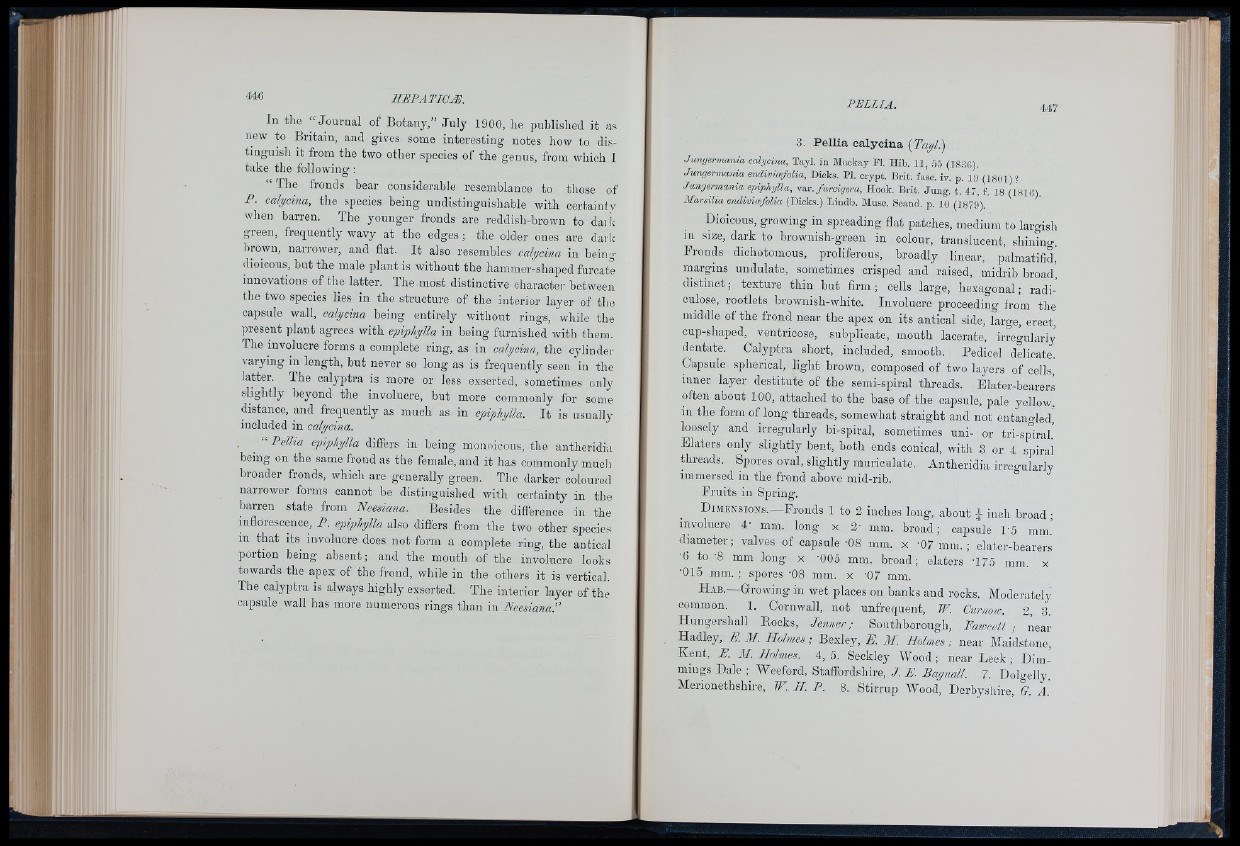
In the “ Journal of Botany.” July 1900, he published it as
new to Britain, and gives some interesting notes how to dis-
tinguish it from the two other species of the genus, from which 1
take the following :
“ The fronds bear considerable resemblance to those of
P. calycina, the species being undistinguishable with certainty
when barren. The younger fronds are reddish-brown to daik
green, frequently wavy at the edges ; the older ones are clai k
lirown, narrower, and flat. I t also resembles calycina in being
dioicous, hut the male plant is without the hammer-shaped furcate
innovations of the latter. The most distinctive character between
the two species lies in the structure of the interior layer of the
capsule wall, calycina being entirely without rings, while the
present plant agrees with epiphylla in being furnished with them.
The involucre forms a complete ring, as in calynna, the cylindei-
varying in length, but never so long as is frequently seen in the
latter. The calyptra is more or less exserted, sometimes only
slightly beyond the involucre, but more commonly for some
distance, and frequently as much as in epiphylla. I t is usually
included in calycina.
“Pellia epip¡hylla differs in being monoicous, tbe antheridia
being on the same frond as the female, and it has commonly mucli
broader fronds, which are generally green. The darker coloured
narrower forms cannot be distinguislied with certainty in the
barren state from Neesiana. Besides the difference in the
inflorescence, P. epiphylla also differs from the two otlier species
in that its involucre does not form a complete ring, the antical
portion being absent; and the mouth of the involucre looks
towards the apex of the frond, while in the others it is vertical.
The calyptra is always highly exserted. The interior layer of the
capsule wall has more numerous rings than in Neesiana!’
3. Pellia calycina (Tayl)
Jungermania calycina, Tayl. in Mackay PI. Hib. 1 1 , 55 (1830).
Jungermania endivkefoUa, Dicks. PI. ciypt. Brit, fa’sc. iv. p. 19 ( 18 0 1 ) ?
Jungermania epiphylla, \a.Y. furcigera, Plook. Brit. Jung. t. 47, f. 18 (1810)
Marsilia endivicefolia (Dicks.) Lindb. Muse. Scand. p. 10 (1879).
Dioicous, grovving in spreading flat patches, medium to largish
m size, dark to brownish-green in colour, translucent, shining.
Fronds dichotomous, proliferous, broadly linear, palmatifid,
margins undulate, sometimes crisped and raised, midrib broad,
distinct; texture thin but firm; cells large, hexagonal; radiculose,
rootlets brownish-white. Involucre proceeding from the
middle of the frond near the apex on its antieal side, large, erect,
cup-shaped, ventricose, subplicate, mouth lacerate, irregularly
dentate. Calyptra short, included, smooth. Pedicel delicate.
Capsule spherical, light brown, composed of two layers of cells,
inner layer destitute of the semi-spiral threads. Elater-bearers
often about 100, attached to the base of the capsule, pale yellow,
in the form of long threads, somewhat straight and not entangled
loosely and irregularly bi-spiral, sometimes uni- or tri-spiral.’
Elaters only slightly bent, both ends conical, with 3 or 4 spiral
threads. Spores oval, slightly muriculate. Antheridia irregularly
immersed in the frond above mid-rib.
Fruits in Spring.
D imensions.— Fronds 1 to 2 inches long, about J inch broad •
involucre 4- mm. long x 2' mm. broad; capsule lA mm.’
diameter; valves of capsule-08 mm. x ■07 mm.; elater-bearers
•6 to -8 mm long x '005 mm. broad; elaters T75 mm. x
■015 mm. ; spores ■08 mm. x ^07 mm.
H ab.— Growing in wet places on banks and rocks. Moderatelj-
common. 1. Cornwall, not unfrequent, TV. Cm iioto. 2, 3.
Hungershall Rocks, Jenner; Southborough, Fawcett, ; near
Hadley, E. M. Holmes; Bexley, E. M. Holmes; near Maidstone
Kent, F. M. Jlolmes. 4, 5. Seokley Wood; near Leek; Dim-’
mings Dale ; Weeford, Staffordshire, J. F. Bagnall. 7. Dolgelly
Merionetlishire, W. H. P. 8. Stirrup Wood, Derbyshire, & A.’